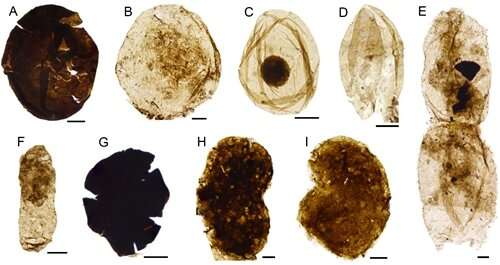Simple vesicles of uncertain biological affinity from the Xiamaling assemblage. Credit: NIGPAS
The mid-Proterozoic (1.85-0.85 Ga), considered the 'boring billion', was a critical time for early evolution of eukaryotic organisms.
Recently, an international research group led by Prof. Zhu Maoyan from the Nanjing Institute of Geology and Paleontology of the Chinese Academy of Sciences (NIGPAS) revealed a diverse organic-walled microfossil (OWM) assemblage from the shale-dominated Mesoproterozoic Xiamaling Formation (ca. 1.4-1.35 Ga) in the Yanshan area, North China.
Their findings were published in Precambrian Research.
The well-preserved OWMs in the assemblage are classified into 36 form species belonging to 28 genera, including one new species and five unnamed taxa, consisting of various individual vesicles, filamentous microfossils and cellular aggregates (or colonial microfossils). "Most of these taxa are reported for the first time in the Xiamaling Formation," said Prof. Zhu.
Among them, the researchers inferred 12 taxa with eukaryotic affinity on the basis of the combined characteristics of complex morphology and large cell size.
These eukaryotic fossils are predominately spheroidal vesicles with micron-scale surface ornamentations or sculptures (e.g. tubular process, reticulate sculpture, concentric striations, verrucae, outer membrane, equatorial flange), and spheroidal to ellipsoidal vesicles with complex wall structure (e.g. tessellated wall, double-wall construction), and one large tubular taxon Jixiania lineata with longitudinal equidistant striations.
According to the researchers, the fossil assemblage shows a moderate eukaryotic diversity which is similar to other contemporaneous OWMs worldwide. This demonstrated that the prokaryotes may have still dominated the Mesoproterozoic ecosystems, but eukaryotic life had shown a certain degree of diversification during the Earth's middle age.
In addition, Jixiania lineata represents the only taxon in the Xiamaling assemblage with relatively short stratigraphic range, and has been reported from several early Mesoproterozoic successions in Australia, Siberia and Laurentia.
The recognition of Jixiania lineata in North China expands its geographic distribution and further enhances its potential as index fossil for early Mesoproterozoic strata.
More information: Lanyun Miao et al, A diverse organic-walled microfossil assemblage from the Mesoproterozoic Xiamaling Formation, North China, Precambrian Research (2021). DOI: 10.1016/j.precamres.2021.106235
Provided by Chinese Academy of Sciences
























